Inspired by Susan Mayclin Stephenson’s Michael Olaf’s Essential Montessori
If you ask me “Which educational methods are timeless and transformative?” my simple answer to you would be: “the Montessori Method Of Education.”The reason behind this affirmation is that this method respects the natural development of children and allows their innate desire to learn, explore, and grow.
This method was originally crafted by the visionary Dr.Maria Montessori. Susan Mayclin Stephenson’s Michael Olaf’s Essential Montessori: School Edition For Ages 3-12+ is one of the most insightful resources on this subject. Her analysis summarizes the essence of Montessori education for teachers and parents alike.
A Method Rooted In Observation And Respect:
Maria Montessori was Italy’s first female physician. She excelled not only in medicine but was a pioneer in educational theory also.
For several years she observed children scientifically. Finally, she concluded that children thrive when allowed to work independently in a carefully prepared environment. Stephenson’s theory echoes the same concept.
She writes, “The child who is permitted to educate himself gives up lower instincts and treads the path of joy and love.” This philosophy encourages us to see children not as passive recipients of knowledge but as active participants in their growth.
The Prepared Environment: A Key To Learning:
One of the striking features of the Montessori Method is the ‘prepared environment”. Stephenson in his book describes “prepared environment “as a thoughtfully designed environment arranged with tools and materials that stimulate curiosity, creativity, and independence. Furthermore, she elaborates that teachers or parents give children the freedom to choose tasks, move around the classroom, and collaborate across age groups.
Moreover, this setup is free of rigid schedules and traditional grading. To validate this Stephenson asserts,” It’s not the richness of the environment, but the preparation of the teacher that determines success,”
Multi-Age Classrooms & Cosmic Education:
In his book, Stephenson asserts the importance of Montessori’s multi-age classrooms. He explains how multi-age classrooms allow children to learn from older peers.
When children reach the age of 6, they are introduced to “Cosmic Education”, a concept or an integrated curriculum that helps children see the interdependence of all things history, science, geography, and culture.
Beyond the Classroom: A Way of Life:
The Montessori Method is considered time-tested due to its holistic approach. Whether in the classroom or at home, the principles remain the same: respect, observation, independence, and love. Practical life skills—cooking, cleaning, gardening, and caring for others—are not side lessons; they’re foundational to the child’s development.
This book is a must-read for parents or educators eager to understand the Montessori approach deeply.
Credit: This blog post is inspired by and based on Michael Olaf’s Essential Montessori: School Edition for Ages 3–12+ by Susan Mayclin Stephenson. All rights and insights belong to the original author.

Sumanta De is an educator. He has been teaching students for more than 16 years following the principles of Dr.Maria Montessori. He has a 7-year-old son and a 5-year-old daughter.
He is nurturing his children abiding by the principles of Dr.Maria Montessori. His passion for Montessori methods goes beyond the classroom.
Hence, he shares his experiences and insights through a dedicated Montessori blog and a YouTube channel under the name “NewChild Montessori”. He aims to offer valuable guidance to both parents and educators.
Education: M.A. English, Masters in Child Psychology & Bachelor’s Degree in Montessori Teachers Training